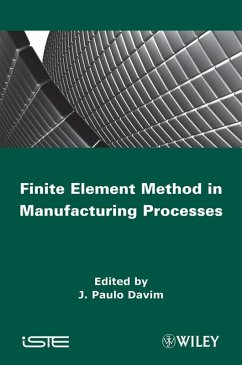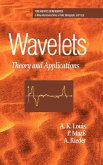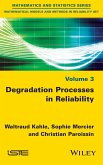Finite Element Method in Manufacturing Processes
Herausgeber: Davim, J Paulo
Finite Element Method in Manufacturing Processes
Herausgeber: Davim, J Paulo
- Gebundenes Buch
- Merkliste
- Auf die Merkliste
- Bewerten Bewerten
- Teilen
- Produkt teilen
- Produkterinnerung
- Produkterinnerung
Nowadays, the finite element method (FEM) has become the main instrument for simulating manufacturing processes. It is made up of a complex process involving a variety of physical phenomena, such as plastic deformation, frictional contact, thermo-mechanical coupling, burr formation mechanisms, etc. Experimental approaches to study the manufacturing processes are important but they can be replaced by FEM analysis, especially when a wide range of parameters is involved such as process parameters, material of the workpiece and tool types. This book aims to provide some fundamentals on research…mehr
Andere Kunden interessierten sich auch für
![Introduction to the Explicit Finite Element Method for Nonlinear Transient Dynamics Introduction to the Explicit Finite Element Method for Nonlinear Transient Dynamics]() Shen R WuIntroduction to the Explicit Finite Element Method for Nonlinear Transient Dynamics141,99 €
Shen R WuIntroduction to the Explicit Finite Element Method for Nonlinear Transient Dynamics141,99 €![Wavelets Wavelets]() A K LouisWavelets202,99 €
A K LouisWavelets202,99 €![An Introduction to Numerical Methods and Analysis, Solutions Manual An Introduction to Numerical Methods and Analysis, Solutions Manual]() James F EppersonAn Introduction to Numerical Methods and Analysis, Solutions Manual43,99 €
James F EppersonAn Introduction to Numerical Methods and Analysis, Solutions Manual43,99 €![Degradation Processes in Reliability Degradation Processes in Reliability]() Waltraud KahleDegradation Processes in Reliability164,99 €
Waltraud KahleDegradation Processes in Reliability164,99 €![MATLAB 7 MATLAB 7]() Christoph W. ÜberhuberMATLAB 759,99 €
Christoph W. ÜberhuberMATLAB 759,99 €![Security for Wireless Sensor Networks Using Identity-Based Cryptography Security for Wireless Sensor Networks Using Identity-Based Cryptography]() Harsh Kupwade PatilSecurity for Wireless Sensor Networks Using Identity-Based Cryptography183,99 €
Harsh Kupwade PatilSecurity for Wireless Sensor Networks Using Identity-Based Cryptography183,99 €![Numerical Methods for Inverse Problems Numerical Methods for Inverse Problems]() Michel KernNumerical Methods for Inverse Problems164,99 €
Michel KernNumerical Methods for Inverse Problems164,99 €-
-
-
Nowadays, the finite element method (FEM) has become the main instrument for simulating manufacturing processes. It is made up of a complex process involving a variety of physical phenomena, such as plastic deformation, frictional contact, thermo-mechanical coupling, burr formation mechanisms, etc. Experimental approaches to study the manufacturing processes are important but they can be replaced by FEM analysis, especially when a wide range of parameters is involved such as process parameters, material of the workpiece and tool types. This book aims to provide some fundamentals on research advances on FEM applied in manufacturing processes such as machining, bulk deformation, sheet metal forming, surface treatments, micromanufacturing processes, etc. Useful as a research book for final undergraduate engineering courses (for example, mechanical, manufacturing, etc.) or as a subject on numerical methods at the postgraduate level, this book can also serve as a useful reference for academics, manufacturing researchers, mechanical and manufacturing engineers and professionals in relation to manufacturing and computational mechanics.
Produktdetails
- Produktdetails
- Verlag: Wiley
- Seitenzahl: 246
- Erscheinungstermin: 8. März 2011
- Englisch
- Abmessung: 239mm x 160mm x 20mm
- Gewicht: 499g
- ISBN-13: 9781848212824
- ISBN-10: 1848212828
- Artikelnr.: 35345420
- Herstellerkennzeichnung
- Libri GmbH
- Europaallee 1
- 36244 Bad Hersfeld
- gpsr@libri.de
- Verlag: Wiley
- Seitenzahl: 246
- Erscheinungstermin: 8. März 2011
- Englisch
- Abmessung: 239mm x 160mm x 20mm
- Gewicht: 499g
- ISBN-13: 9781848212824
- ISBN-10: 1848212828
- Artikelnr.: 35345420
- Herstellerkennzeichnung
- Libri GmbH
- Europaallee 1
- 36244 Bad Hersfeld
- gpsr@libri.de
J. Paulo Davim is Aggregate Professor in the Department of Mechanical Engineering at the University of Aveiro, Portugal and is Head of MACTRIB (Machining and Tribology Research Group). His main research interests include machining/manufacturing processes and tribology/surface engineering.
Chapter 1 Authentication of FEM in Metal Cutting Viktor P. Astakhov 1
1.1 Introduction 2
1.2 What seems to be the problem? 3
1.2.1 Practical use of metal cutting theories and the FEM 4
1.2.2 Need for proper simulations in metal cutting 5
1.3 FEM in metal cutting: issues that need to be addressed 9
1.3.1 Clear objectives of FEM simulations 9
1.3.2 Proper definition of the metal-cutting process and physically sound
model 11
1.3.3 Work material model 15
1.4 Verification of the FEM in metal cutting 31
1.4.1 Common sense verification 33
1.4.2 Geometrical and metallographical similarities 34
1.4.3 Deformation similarity 36
1.4.4 Thermodynamic similarity 39
1.5 Bibliography 40
Chapter 2 Finite Element Modeling of HSM with Coated Tools Muhammad FAHAD
Paxil T. Mativenga Mohammad A. Sheikh
2.1 Introduction 46
2.2 Metal cutting' 47
2.2.1 Orthogonal cutting model 47
2.2.2 HSM 48
2.3 Cutting tools and coatings 51
2.3.1 Properties of hard coatings 53
2.3.2 Restricted contact length 55
2.4 Heat generation and distribution in machining 59
2.4.1 Estimation of heat source on the rake face 61
2.5 Finite element analysis (FEA) of the machining process 62
2.6 Experimental details 67
2.6.1 Temperature measurement 68
2.7 FE transient heat transfer analysis 70
2.8 Results and discussion 73
2.8.1 Cutting forces 73
2.8.2 Chip compression ratio 74
2.8.3 Tool-chip contact area and phenomena 75
2.9 Heat partition into the cutting tool 78
2.10 Conclusions 84
2.11 Bibliography 85
Chapter 3 Experimental and Numerical Modeling of Tube End-Forming Processes
Pedro A. R. Rosa Luis M. Alves Paulo A. F. Martins 93
3.1 Introduction 93
3.2 Theoretical background 96
3.2.1 Cold forming of metals and polymers 96
3.2.2 Extended finite element flow formulation 98
3.3 Experimentation 101
3.3.1 Stress-strain curve 101
3.3.2 Density 102
3.3.3 Critical instability load 104
3.4 Mechanics of deformation 105
3.4.1 Invert forming 105
3.4.2 Expansion and reduction 113
3.4.3 Compression beading and nosing 117
3.4.4 End forming of PVC tubes 120
3.5 Innovative applications 126
3.6 Conclusions 131
3.7 Bibliography 133
Chapter 4 Finite Element Modeling of Rolling Processes Uday Shankar Dixit
137
4.1 Introduction 137
4.2 Background on the FEM 140
4.3 Flow formulation of the cold rolling processes 142
4.4 Updated Lagrangian formulation of cold rolling processes 154
4.5 Formulation for hot rolling processes 161
4.5.1 Heat transfer equations 162
4.5.2 Material behavior 164
4.6 Conclusions 169
4.7 Bibliography 169
Chapter 5 Finite Element Modeling of Ball-Burnishing Surface Treatments
Ainhoa Celaya Luis Norberto López De Lacalle Joseba Albizuri Adrian
Rodriguez Aitzol Lamikiz 173
5.1 Introduction 173
5.2 Modeling of the ball-burnishing process 177
5.2.1 Preliminary considerations 179
5.2.2 Simulation of the ball movement 183
5.2.3 Simulation results 186
5.3 Model validation 193
5.3.1 Experimental set up 193
5.3.2 Results and discussion 194
5.4 Summary and conclusions 196
5.5 Acknowledgments 197
5.6 Bibliography 198
Chapter 6 Combining the Finite Element Method and Artificial Intelligence
in Manufacturing Modeling and Optimization Ramon Quiza J. Paulo Davim 201
6.1 Introduction 201
6.2 A brief overview on AI techniques 203
6.2.1 AI techniques for modeling 203
6.2.2 AI techniques for optimizing 211
6.3 Approaches for combining the FEM and AI in machining research 214
6.3.1 Approaches for combining the FEM and AI in machining modeling 214
6.3.2 Approaches for combining FEM and AI in machining optimization 219
6.4 An application sample 221
6.4.1 Problem definition 221
6.4.2 Simulation 223
6.4.3 Neural network-based modeling 226
6.4.4 Genetic algorithm-based optimization 230
6.4.5 Experimental validation 235
6.5 Concluding remarks 235
6.6 Bibliography 236
List of Authors 241
Index 245
1.1 Introduction 2
1.2 What seems to be the problem? 3
1.2.1 Practical use of metal cutting theories and the FEM 4
1.2.2 Need for proper simulations in metal cutting 5
1.3 FEM in metal cutting: issues that need to be addressed 9
1.3.1 Clear objectives of FEM simulations 9
1.3.2 Proper definition of the metal-cutting process and physically sound
model 11
1.3.3 Work material model 15
1.4 Verification of the FEM in metal cutting 31
1.4.1 Common sense verification 33
1.4.2 Geometrical and metallographical similarities 34
1.4.3 Deformation similarity 36
1.4.4 Thermodynamic similarity 39
1.5 Bibliography 40
Chapter 2 Finite Element Modeling of HSM with Coated Tools Muhammad FAHAD
Paxil T. Mativenga Mohammad A. Sheikh
2.1 Introduction 46
2.2 Metal cutting' 47
2.2.1 Orthogonal cutting model 47
2.2.2 HSM 48
2.3 Cutting tools and coatings 51
2.3.1 Properties of hard coatings 53
2.3.2 Restricted contact length 55
2.4 Heat generation and distribution in machining 59
2.4.1 Estimation of heat source on the rake face 61
2.5 Finite element analysis (FEA) of the machining process 62
2.6 Experimental details 67
2.6.1 Temperature measurement 68
2.7 FE transient heat transfer analysis 70
2.8 Results and discussion 73
2.8.1 Cutting forces 73
2.8.2 Chip compression ratio 74
2.8.3 Tool-chip contact area and phenomena 75
2.9 Heat partition into the cutting tool 78
2.10 Conclusions 84
2.11 Bibliography 85
Chapter 3 Experimental and Numerical Modeling of Tube End-Forming Processes
Pedro A. R. Rosa Luis M. Alves Paulo A. F. Martins 93
3.1 Introduction 93
3.2 Theoretical background 96
3.2.1 Cold forming of metals and polymers 96
3.2.2 Extended finite element flow formulation 98
3.3 Experimentation 101
3.3.1 Stress-strain curve 101
3.3.2 Density 102
3.3.3 Critical instability load 104
3.4 Mechanics of deformation 105
3.4.1 Invert forming 105
3.4.2 Expansion and reduction 113
3.4.3 Compression beading and nosing 117
3.4.4 End forming of PVC tubes 120
3.5 Innovative applications 126
3.6 Conclusions 131
3.7 Bibliography 133
Chapter 4 Finite Element Modeling of Rolling Processes Uday Shankar Dixit
137
4.1 Introduction 137
4.2 Background on the FEM 140
4.3 Flow formulation of the cold rolling processes 142
4.4 Updated Lagrangian formulation of cold rolling processes 154
4.5 Formulation for hot rolling processes 161
4.5.1 Heat transfer equations 162
4.5.2 Material behavior 164
4.6 Conclusions 169
4.7 Bibliography 169
Chapter 5 Finite Element Modeling of Ball-Burnishing Surface Treatments
Ainhoa Celaya Luis Norberto López De Lacalle Joseba Albizuri Adrian
Rodriguez Aitzol Lamikiz 173
5.1 Introduction 173
5.2 Modeling of the ball-burnishing process 177
5.2.1 Preliminary considerations 179
5.2.2 Simulation of the ball movement 183
5.2.3 Simulation results 186
5.3 Model validation 193
5.3.1 Experimental set up 193
5.3.2 Results and discussion 194
5.4 Summary and conclusions 196
5.5 Acknowledgments 197
5.6 Bibliography 198
Chapter 6 Combining the Finite Element Method and Artificial Intelligence
in Manufacturing Modeling and Optimization Ramon Quiza J. Paulo Davim 201
6.1 Introduction 201
6.2 A brief overview on AI techniques 203
6.2.1 AI techniques for modeling 203
6.2.2 AI techniques for optimizing 211
6.3 Approaches for combining the FEM and AI in machining research 214
6.3.1 Approaches for combining the FEM and AI in machining modeling 214
6.3.2 Approaches for combining FEM and AI in machining optimization 219
6.4 An application sample 221
6.4.1 Problem definition 221
6.4.2 Simulation 223
6.4.3 Neural network-based modeling 226
6.4.4 Genetic algorithm-based optimization 230
6.4.5 Experimental validation 235
6.5 Concluding remarks 235
6.6 Bibliography 236
List of Authors 241
Index 245
Chapter 1 Authentication of FEM in Metal Cutting Viktor P. Astakhov 1
1.1 Introduction 2
1.2 What seems to be the problem? 3
1.2.1 Practical use of metal cutting theories and the FEM 4
1.2.2 Need for proper simulations in metal cutting 5
1.3 FEM in metal cutting: issues that need to be addressed 9
1.3.1 Clear objectives of FEM simulations 9
1.3.2 Proper definition of the metal-cutting process and physically sound
model 11
1.3.3 Work material model 15
1.4 Verification of the FEM in metal cutting 31
1.4.1 Common sense verification 33
1.4.2 Geometrical and metallographical similarities 34
1.4.3 Deformation similarity 36
1.4.4 Thermodynamic similarity 39
1.5 Bibliography 40
Chapter 2 Finite Element Modeling of HSM with Coated Tools Muhammad FAHAD
Paxil T. Mativenga Mohammad A. Sheikh
2.1 Introduction 46
2.2 Metal cutting' 47
2.2.1 Orthogonal cutting model 47
2.2.2 HSM 48
2.3 Cutting tools and coatings 51
2.3.1 Properties of hard coatings 53
2.3.2 Restricted contact length 55
2.4 Heat generation and distribution in machining 59
2.4.1 Estimation of heat source on the rake face 61
2.5 Finite element analysis (FEA) of the machining process 62
2.6 Experimental details 67
2.6.1 Temperature measurement 68
2.7 FE transient heat transfer analysis 70
2.8 Results and discussion 73
2.8.1 Cutting forces 73
2.8.2 Chip compression ratio 74
2.8.3 Tool-chip contact area and phenomena 75
2.9 Heat partition into the cutting tool 78
2.10 Conclusions 84
2.11 Bibliography 85
Chapter 3 Experimental and Numerical Modeling of Tube End-Forming Processes
Pedro A. R. Rosa Luis M. Alves Paulo A. F. Martins 93
3.1 Introduction 93
3.2 Theoretical background 96
3.2.1 Cold forming of metals and polymers 96
3.2.2 Extended finite element flow formulation 98
3.3 Experimentation 101
3.3.1 Stress-strain curve 101
3.3.2 Density 102
3.3.3 Critical instability load 104
3.4 Mechanics of deformation 105
3.4.1 Invert forming 105
3.4.2 Expansion and reduction 113
3.4.3 Compression beading and nosing 117
3.4.4 End forming of PVC tubes 120
3.5 Innovative applications 126
3.6 Conclusions 131
3.7 Bibliography 133
Chapter 4 Finite Element Modeling of Rolling Processes Uday Shankar Dixit
137
4.1 Introduction 137
4.2 Background on the FEM 140
4.3 Flow formulation of the cold rolling processes 142
4.4 Updated Lagrangian formulation of cold rolling processes 154
4.5 Formulation for hot rolling processes 161
4.5.1 Heat transfer equations 162
4.5.2 Material behavior 164
4.6 Conclusions 169
4.7 Bibliography 169
Chapter 5 Finite Element Modeling of Ball-Burnishing Surface Treatments
Ainhoa Celaya Luis Norberto López De Lacalle Joseba Albizuri Adrian
Rodriguez Aitzol Lamikiz 173
5.1 Introduction 173
5.2 Modeling of the ball-burnishing process 177
5.2.1 Preliminary considerations 179
5.2.2 Simulation of the ball movement 183
5.2.3 Simulation results 186
5.3 Model validation 193
5.3.1 Experimental set up 193
5.3.2 Results and discussion 194
5.4 Summary and conclusions 196
5.5 Acknowledgments 197
5.6 Bibliography 198
Chapter 6 Combining the Finite Element Method and Artificial Intelligence
in Manufacturing Modeling and Optimization Ramon Quiza J. Paulo Davim 201
6.1 Introduction 201
6.2 A brief overview on AI techniques 203
6.2.1 AI techniques for modeling 203
6.2.2 AI techniques for optimizing 211
6.3 Approaches for combining the FEM and AI in machining research 214
6.3.1 Approaches for combining the FEM and AI in machining modeling 214
6.3.2 Approaches for combining FEM and AI in machining optimization 219
6.4 An application sample 221
6.4.1 Problem definition 221
6.4.2 Simulation 223
6.4.3 Neural network-based modeling 226
6.4.4 Genetic algorithm-based optimization 230
6.4.5 Experimental validation 235
6.5 Concluding remarks 235
6.6 Bibliography 236
List of Authors 241
Index 245
1.1 Introduction 2
1.2 What seems to be the problem? 3
1.2.1 Practical use of metal cutting theories and the FEM 4
1.2.2 Need for proper simulations in metal cutting 5
1.3 FEM in metal cutting: issues that need to be addressed 9
1.3.1 Clear objectives of FEM simulations 9
1.3.2 Proper definition of the metal-cutting process and physically sound
model 11
1.3.3 Work material model 15
1.4 Verification of the FEM in metal cutting 31
1.4.1 Common sense verification 33
1.4.2 Geometrical and metallographical similarities 34
1.4.3 Deformation similarity 36
1.4.4 Thermodynamic similarity 39
1.5 Bibliography 40
Chapter 2 Finite Element Modeling of HSM with Coated Tools Muhammad FAHAD
Paxil T. Mativenga Mohammad A. Sheikh
2.1 Introduction 46
2.2 Metal cutting' 47
2.2.1 Orthogonal cutting model 47
2.2.2 HSM 48
2.3 Cutting tools and coatings 51
2.3.1 Properties of hard coatings 53
2.3.2 Restricted contact length 55
2.4 Heat generation and distribution in machining 59
2.4.1 Estimation of heat source on the rake face 61
2.5 Finite element analysis (FEA) of the machining process 62
2.6 Experimental details 67
2.6.1 Temperature measurement 68
2.7 FE transient heat transfer analysis 70
2.8 Results and discussion 73
2.8.1 Cutting forces 73
2.8.2 Chip compression ratio 74
2.8.3 Tool-chip contact area and phenomena 75
2.9 Heat partition into the cutting tool 78
2.10 Conclusions 84
2.11 Bibliography 85
Chapter 3 Experimental and Numerical Modeling of Tube End-Forming Processes
Pedro A. R. Rosa Luis M. Alves Paulo A. F. Martins 93
3.1 Introduction 93
3.2 Theoretical background 96
3.2.1 Cold forming of metals and polymers 96
3.2.2 Extended finite element flow formulation 98
3.3 Experimentation 101
3.3.1 Stress-strain curve 101
3.3.2 Density 102
3.3.3 Critical instability load 104
3.4 Mechanics of deformation 105
3.4.1 Invert forming 105
3.4.2 Expansion and reduction 113
3.4.3 Compression beading and nosing 117
3.4.4 End forming of PVC tubes 120
3.5 Innovative applications 126
3.6 Conclusions 131
3.7 Bibliography 133
Chapter 4 Finite Element Modeling of Rolling Processes Uday Shankar Dixit
137
4.1 Introduction 137
4.2 Background on the FEM 140
4.3 Flow formulation of the cold rolling processes 142
4.4 Updated Lagrangian formulation of cold rolling processes 154
4.5 Formulation for hot rolling processes 161
4.5.1 Heat transfer equations 162
4.5.2 Material behavior 164
4.6 Conclusions 169
4.7 Bibliography 169
Chapter 5 Finite Element Modeling of Ball-Burnishing Surface Treatments
Ainhoa Celaya Luis Norberto López De Lacalle Joseba Albizuri Adrian
Rodriguez Aitzol Lamikiz 173
5.1 Introduction 173
5.2 Modeling of the ball-burnishing process 177
5.2.1 Preliminary considerations 179
5.2.2 Simulation of the ball movement 183
5.2.3 Simulation results 186
5.3 Model validation 193
5.3.1 Experimental set up 193
5.3.2 Results and discussion 194
5.4 Summary and conclusions 196
5.5 Acknowledgments 197
5.6 Bibliography 198
Chapter 6 Combining the Finite Element Method and Artificial Intelligence
in Manufacturing Modeling and Optimization Ramon Quiza J. Paulo Davim 201
6.1 Introduction 201
6.2 A brief overview on AI techniques 203
6.2.1 AI techniques for modeling 203
6.2.2 AI techniques for optimizing 211
6.3 Approaches for combining the FEM and AI in machining research 214
6.3.1 Approaches for combining the FEM and AI in machining modeling 214
6.3.2 Approaches for combining FEM and AI in machining optimization 219
6.4 An application sample 221
6.4.1 Problem definition 221
6.4.2 Simulation 223
6.4.3 Neural network-based modeling 226
6.4.4 Genetic algorithm-based optimization 230
6.4.5 Experimental validation 235
6.5 Concluding remarks 235
6.6 Bibliography 236
List of Authors 241
Index 245








